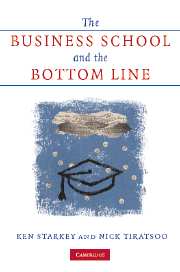Book contents
- Frontmatter
- Contents
- List of tables
- Acknowledgements
- Prologue
- 1 Introduction
- 2 The development and diffusion of the business school
- 3 Business schools in the era of hyper-competition: ‘more “business” and less “school”’
- 4 Business school education
- 5 Business school research
- 6 Experiments and innovations
- 7 Imaginary MBAs
- 8 Business school futures: mission impossible?
- Epilogue
- Index
2 - The development and diffusion of the business school
Published online by Cambridge University Press: 02 December 2009
- Frontmatter
- Contents
- List of tables
- Acknowledgements
- Prologue
- 1 Introduction
- 2 The development and diffusion of the business school
- 3 Business schools in the era of hyper-competition: ‘more “business” and less “school”’
- 4 Business school education
- 5 Business school research
- 6 Experiments and innovations
- 7 Imaginary MBAs
- 8 Business school futures: mission impossible?
- Epilogue
- Index
Summary
It is tempting to assume that business schools – and the MBA qualification that is their touchstone – must always have been much as they are today, an integral component of modern life. The schools seem to have such permanence and ubiquity that it is difficult to think of the world without them. Everywhere, it seems, with the possible exception of parts of Africa, they thrive. They are woven into higher education, the business system and the culture. In short, they just seem to be part of the furniture. Yet there is much more of a story here than meets the eye. The classic business school is of surprisingly recent origin. It emerged in the United States at the end of the nineteenth century, and then only started to be copied in the rest of the world several decades later. Moreover, wherever business schools appeared they tended to be accompanied by controversy. Some believed that there were better ways of developing business and management skills; more doubted whether such skills either could or should actually be taught at all. In this environment, the whole sector developed awkwardly, and was prone to periodic bouts of soul-searching and crisis. In this chapter, we examine this rather chequered history in detail, attempt to uncover its basic dynamics, and then look briefly at some aspects of its legacy.
THE MARCH OF BUSINESS SCHOOLS
The early rise of the business school in the United States was in many respects astonishing. The pioneering Wharton School was founded in 1881. By the turn of the twentieth century there were two other similar institutions.
- Type
- Chapter
- Information
- The Business School and the Bottom Line , pp. 15 - 49Publisher: Cambridge University PressPrint publication year: 2007



